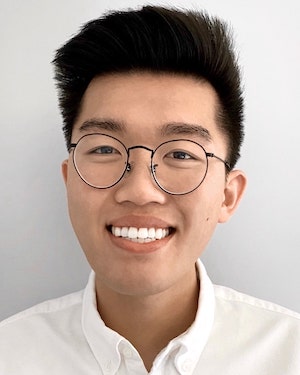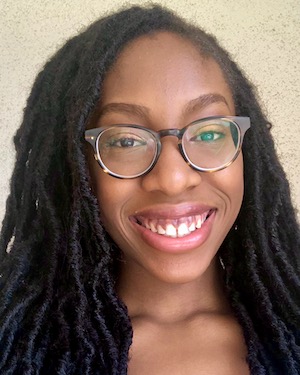Student Blog

The Benefits of Remote Learning ⟩
June 8, 2020, by Savi
Pursuing my Entry-Level Professional Master of Arts Degree at USC in the Chan Division of Occupational Science and Occupational Therapy has provided me with a plethora of opportunities to grow as a student and as a future OT. I have been challenged by the curriculum, by my peers, and by my professors to think outside of the box and develop innovative ways to overcome a variety of barriers and challenges. Out of all these challenges, one of the biggest was transitioning our curriculum to remote learning due to the COVID-19 pandemic.
As many who know me would agree, I am not particularly tech-savvy, I am an extremely hands-on learner, and I thrive in social settings. For those reasons, the transition to remote learning seemed somewhat daunting to me. In order to overcome the frustration and fear I had, I decided to develop a list of the benefits of remote learning that I discovered over the last few months. This helped me focus on the positive aspects of remote learning and find the motivation to overcome the hurdles I faced in order to succeed both academically and socially under the circumstances.
For those of you reading this who are about to start their first semester with us at USC in the Chan Division, I know that this is not the same beginning you might have envisioned. For many, that may be frustrating and sad and for some, this may be great news! Whatever you are feeling is valid and I wanted to provide you with the list of the positive aspects I have discovered about taking my courses remotely. I hope that these help you to better enjoy your first semester with us! To those of you already in the program, I hope that this list also helps you if you ever feel like you’re viewing these circumstances in an extremely negative light. On that note . . . here comes my list!
The Benefits of Remote Learning:
- No commute: You can roll right out of bed and into class, plus you can wear your pajamas to school!
- Creativity Boost: As an OT, the number one skill we utilize is creativity. Transitioning to an online format has challenged us to become more creative. Whether that is altering an in-person group therapy session to fit a video conference format, discovering the best way to present a group research paper to our class online, or discovering occupations to utilize during, in between or before class that help us sustain engagement in class, we will all become more well-rounded OTs because of these experiences.
- A better understanding of who your professors are outside of the classroom: I know what you might be thinking . . . how would you get to know someone better through a virtual format than you would in person? Great question! This was the first time I got to see some of my professors and other faculty outside of a true classroom setting. I was able to meet my professors’ family members, animals, and friends and see them in their “comfy clothes” during our one-on-one meetings. These experiences made them even more relatable than before!
- Greater access to office hours: Because I no longer have to travel to school to meet with my professors, I can meet with them ANY TIME! While on campus my professors would make themselves extremely accessible. Now that neither of us has to commute, it has become easier to squeeze in more meetings throughout the day.
- Building relationships with other faculty in the division: Shout out to IT Helpdesk and A/V Technician David Xie, Webmaster Paul Bailey, and the rest of the IT team for helping me overcome the many hurdles I have faced as a student who is not tech-savvy.
- Hearing from more students in your class: Because students can utilize both the chat and the unmute feature, more students can respond to a question posed by the professor during class. Although there is limited time to hear from students during lectures, the chat feature allows for an unlimited amount of responses. This has given me the opportunity to learn from a lot of my classmates’ opinions and experiences.
- Enjoying yoga, meditation, or even a quick nap during a class break! I promise these are very revitalizing occupations, so I urge you to take advantage of them while you can.
⋯

Black Lives Matter ⟩
June 8, 2020, by Calvin
It’s been an extremely unfortunate time right now and I know that so many of us are going through a lot of emotions. Like many of you, I feel disappointed, angry, frustrated, and scared by the current events surrounding the unfair deaths of Black lives. As I’m watching the news on the ensuing nationwide protests for social justice, I’m witnessing the collective trauma being experienced by many, and I am also reflecting on how I can help.
I am proud to be part of the Chan Community, where the USC Chan Division has been committed to addressing these matters by fostering an inclusive educational environment, sharing multiple resources, and holding safe space meetings. It’s reassuring to know that our community is being supported by the division and I’m very much looking forward to attending these meetings.
As an Asian American, I used to believe that this was not my place to speak up and that this was not my fight. I believed that if I felt like I was going to say something wrong, then I shouldn’t say anything at all. In the past, I was silent and scared to have these difficult conversations with my friends and family. I remember times when friends would use derogatory language against certain communities and when my immigrant family members would share their opinions without first attempting to understand. I didn’t say a word to try and correct them. I wasn’t able to resist my complacency.
Throughout my upbringing, I had internalized anti-blackness and my mind was shrouded by the model minority narrative that continues to divide Asian and Black communities. This myth grants exploitative privileges that are weaponized against Black and Latinx communities. I was ignorant to be part of such a detrimental perception that downplays racism in the struggles of other minority groups, especially Black people.
However, as I have grown and reflected on myself and my privilege, I have come to realize that there are many ways to practice allyship in solidarity. By acknowledging the internalized racism embedded within myself and my culture, I have been able to reflect on my actions and challenge my assumptions. I’ve also been trying to promote this dialogue with my family to educate them on the injustices that Black people face. While I am grateful that they are gradually starting to be more open to talking about these topics, I also know that this is just the first step.
Black communities continue to experience barriers to their occupational rights and they continue to have their lives senselessly taken away by authorities who thrive off of this unjust system. It’s very clear that we are still fighting against systemic racism and acts of oppression, and it is so important, and has always been, that we organize and mobilize together in order to educate ourselves and support the Black community.
As future OTs, part of our work is to create a space to listen to the voices of those who are marginalized and oppressed, and to those who don’t have a voice, so that we can help advocate for them. However, we must also challenge people’s assumptions, acknowledge when there is boundary-crossing, and utilize our leadership to foster a supportive and safe environment for our clients and colleagues.
I hope that you can join me in taking this time to reflect and ask ourselves these questions:
- What can I do to continue putting in this effort?
- How can I use anti-racist knowledge to start this dialogue?
- How can I inform myself to continue thinking about these topics?
Here, I share with you all a document that contains links and additional resources to educate yourself, sign petitions, donate, and so many other ways for you to take action. I hope that everyone is staying safe and healthy and that you’re able to take care of yourselves as needed.
Thank you.
⋯

Why Occupational Therapy? ⟩
June 2, 2020, by Savi
From a young age, I have been passionate about a range of interests, including sports, graphic design, leadership, and academic pursuits. When applying to college, I had to focus on which activities would interest me most in a future career. Prioritizing a narrower set of interests was challenging for me since I enjoy exploring new experiences, applying my knowledge in novel ways, and having the opportunity to continuously challenge myself to develop innovative and creative approaches to a problem. These desires, coupled with my personal experiences interacting with occupational therapists in a variety of settings, influenced me to pursue a career in occupational therapy (OT).
After injuring both my thumbs playing as a goalie for my soccer team, I worked with an OT hand therapist during my rehabilitation process. This interaction highlighted to me the importance of creativity in an OT’s approach to designing a treatment plan. My OT worked with me to set goals and develop a treatment plan that best suited my occupational needs. This OT gave me anatomy lessons to help me better understand my injuries and demonstrated ingenuity when developing activities she knew would pique my interest and motivate me. This first hand (or thumb haha) experience taught me that pursuing a career in OT would allow me to continuously challenge myself by developing specialized treatment plans to meet the unique needs of each of my clients, and provide clients with autonomy during their rehabilitation journey.
A few years later, I watched my sister conduct fieldwork immersions while completing her Master’s in Occupational Therapy at USC, and was further convinced that pursuing this profession would allow me to continue to develop innovative approaches to overcome challenging problems in a variety of settings. I witnessed her ability to work with college students to build a foundation of sustainable and healthy routines using Lifestyle Redesign® in the USC Chan Division Faculty Practice, with adults recovering from a stroke, traumatic brain injury, spinal cord injury and amputations in an inpatient rehabilitation setting, and with children with varying abilities in a sensory integration pediatric practice.
I came to better understand the opportunity OTs have to work in diverse environments including mental health, adult rehabilitation or pediatric settings. By choosing a career in OT, I will be equipped with the skills to develop innovative approaches to address specific occupational needs of individuals across the lifespan. I decided to pursue this career to empower the individuals I work with to feel like they can conquer everyday, every task, and every meaningful occupation with confidence and increased independence.
⋯

You’re Studying Occupational Therapy . . . huh? ⟩
June 1, 2020, by Nmachi
As an Occupational Therapy major in the Bachelor’s to Master’s Program, I constantly get the same two questions asked by friends and family: What exactly is occupational therapy and how did you get into it? Since information about what occupational therapy can already be found on this site, I’ll just expand on why I chose to pursue OT.
From a young age, I have always been passionate about direct service and improving quality of life. Being a teacher, pediatrician, and physical therapist have been past career goals for me because each of them were rooted in helping others with their livelihood.
In high school, I began to narrow my interests down to what I actually could consider making a career out of. I came across the field of occupational therapy upon researching different academic programs at my top schools, browsing the USC website, and talking with my sister (an ‘SC alumna).
I became interested in OT because of the opportunity to provide the longitudinal patient interaction needed to help individuals reclaim their health. Because I cannot imagine losing the ability to perform seemingly simple everyday tasks, my desire is to be in a position to give others the hope of regaining their independence.
The day that I received my acceptance package and found out that I was going to be an Occupational Therapy major was probably the most exciting moment I’ve had thus far! Out of all of the universities I applied for during my senior year of high school, the only one that really stood out was USC. I knew that attending USC would completely prepare me for a career in OT (couldn’t pass up the #1 school for OT in the nation!).
With the countless resources that USC provides their students, I continue to look forward to building an educational foundation in OT and taking advantage of service experiences outside of the classroom to ultimately change my community for the better. I am more than ready to make my dreams a reality.
⋯

Why OT? ⟩
June 1, 2020, by Liz
As I reflect about my time thus far at USC Chan, I come to appreciate the diversity in the program and everyone’s unique story in finding occupational therapy. It’s always great to know that no matter the “why,” we all hold a special love for OT. Some learned about OT through their family members, others have had loved ones receive OT services, and some have personal stories about their journey as the recipient. As for me, the story is a little different!
As the proud daughter of a landscaping gardener and housekeeper, growing up I wasn’t introduced to professions outside of what my family knew. However, when I was about 12 years old, my grandmother obtained a traumatic hand injury while in the passenger’s seat of a terrible car accident. She was an undocumented, uninsured individual in our country and could not afford the care she needed. Due to these barriers, my family could only afford to pay for her pain medication. Over time her injury healed, but her wrist permanently remained curving in towards her thumb — radial deviation. The accident negatively impacted my grandmother’s ability to engage in activities she found meaningful. She found it challenging to dress herself independently, make tamales, and walk her dog. This took a toll on my grandma’s self-esteem and created a deep feeling of frustration. I took it upon myself to help my grandma by doing some of those things for her, but what I discovered was that she wanted to do them herself. So, I tried helping my grandma find ways to participate in those activities as best as she could. Sure, it wasn’t the work a 12-year-old should be doing, but it was so fun! I loved seeing my grandma smile every time she was able to put on her favorite red lipstick by herself. Of course, we still had a bit of cleaning up to do around the edges, but it was amazing!
Years later, I ended up at CSUF with the hopes of pursuing a career as a Spanish teacher. I was taking a kinesiology course to fulfill one of my GE requirements and one day a few seniors came in to present on their internship experience. One of those presentations spoke about occupational therapy! Of course, I went home and did my research and was immediately converted when I knew I could work with individuals recovering from hand injuries. However, as time went on, I discovered that my passion went beyond wanting to help people recover from such injuries. My interest flourished into a love for wanting to provide culturally sensitive care for those from lower-socioeconomic statuses, a barrier faced by my grandmother and many others from similar communities. I am grateful that OT provides me with the opportunity to do so. The best part is that I get to work towards my goal with the support of my amazing academic mentors and supportive peers. I look forward to continue representing the Latinx community and am excited to continue growing as a future OT!
⋯





